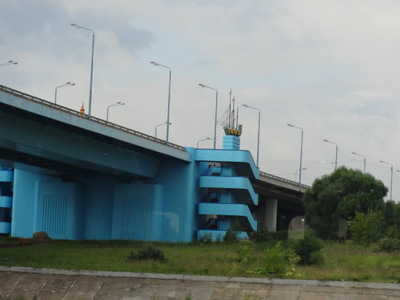
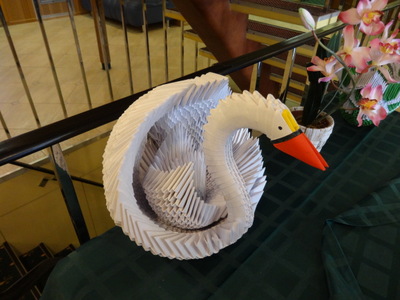 Near our destination, we passed under a bridge with this elaborate, brightly painted, square spiral staircase that permitted pedestrian access. It's topped by an also brightly painted three-masted model ship.
Near our destination, we passed under a bridge with this elaborate, brightly painted, square spiral staircase that permitted pedestrian access. It's topped by an also brightly painted three-masted model ship.Saturday, 5 August, Yaroslavl and beyond
Written 3 September 2017
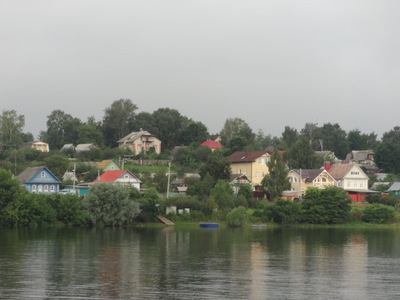
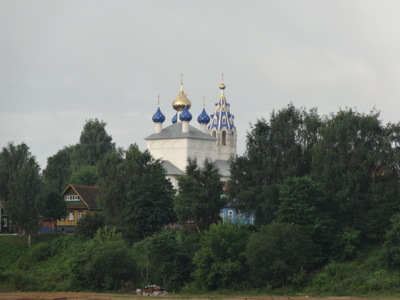 Once again we cruised all night and were still approaching Yaroslavl while we ate breakfast. To get there, we continued on the Volga and into the Rybinsk Reservoir, then a short ways along the south bank of the reservoir, then took a left into the Volga, headed east, away from our main route. On this morning, we saw more signs of civilization along the river banks than we had the day before.
Once again we cruised all night and were still approaching Yaroslavl while we ate breakfast. To get there, we continued on the Volga and into the Rybinsk Reservoir, then a short ways along the south bank of the reservoir, then took a left into the Volga, headed east, away from our main route. On this morning, we saw more signs of civilization along the river banks than we had the day before.
I don't know whether the houses in the left-hand photo were a separate village or just the outskirts of Yaroslavl. These are all things we passed between my arrival in the dining room, ca. 6:30 a.m., and our docking, ca. 8:00 a.m. The building in the right-hand photo can only be a church and was quite close to the cluster of houses.
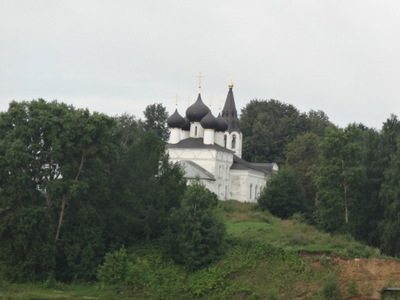
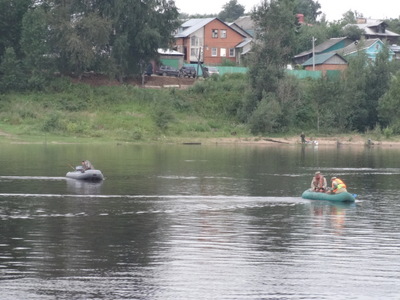
Here's another church, seemingly by itself in the woods, but of course, it might have houses behind it. Just before it, we passed a site where military trainees were erecting a pontoon bridge for practice.
Frequently along this stretch and elsewhere, we passed small boats with guys in them fishing. We never got a chance to ask what they caught and whether the river was clean enough for them to eat the catch. It didn't look or smell especially polluted.

 Near our destination, we passed under a bridge with this elaborate, brightly painted, square spiral staircase that permitted pedestrian access. It's topped by an also brightly painted three-masted model ship.
Near our destination, we passed under a bridge with this elaborate, brightly painted, square spiral staircase that permitted pedestrian access. It's topped by an also brightly painted three-masted model ship.
The Zosima Shashkov was already moored, so we moored outboard of her and had to cross through her lobby to disembark for the day's tour. I loved this beautiful folded-paper swan with which it was decorated.
Yaroslavl has about 600,000 people and is the seat of the administrative district that includes Uglich. Its center is a UNESCO world heritage site. It was founded very early in 11th century. Peter the Great visited in 1715. Three hundred years ago, it was the capital of Russian merchants, and it had lots of tall buildings even early on. In the 17th century, the merchants' families built over 50 churches.
During the revolution, many of the churches weren't actually destroyed but were used as hostels for industrial workers. They're now being restored. The city currently has 22 (active) orthodox churches, 1 monastary, 2 convents, and 1 each of a whole lot of other kinds.
Yaroslavl is one of Russia's Gold Ring cities, prominent in the formation of the Russian church and considered among the country's most picturesque. The city is pround that, in 1750, very first theater production in all of Russia was performed here. We were shown the very theater as we drove by.
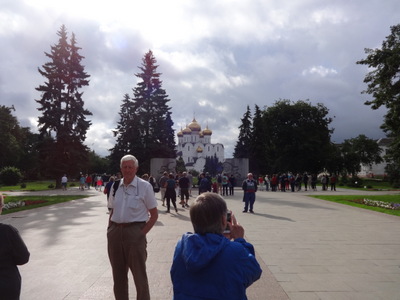
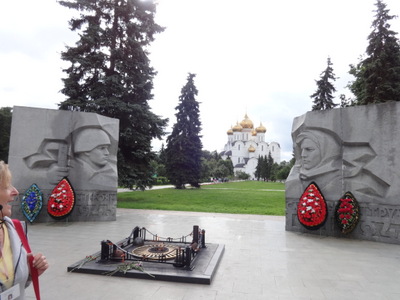 The tour started at 8:15 a.m., so we were up and out early. In a vast park on the river bank, at opposite ends of a long esplanade, the Cathedral of the Dormition (shown here in distant and then in closer view, framed by a memorial to World War II that includes an eternal flame and two stone monuments) faces the Cathedral of Elijah the Prophet.
The tour started at 8:15 a.m., so we were up and out early. In a vast park on the river bank, at opposite ends of a long esplanade, the Cathedral of the Dormition (shown here in distant and then in closer view, framed by a memorial to World War II that includes an eternal flame and two stone monuments) faces the Cathedral of Elijah the Prophet.
We toured both, and this time I bought the little tag to hang around my neck that showed I had paid the fee to take photos. Elijah the Prophet is a museum now, but I think Dormition may be active.
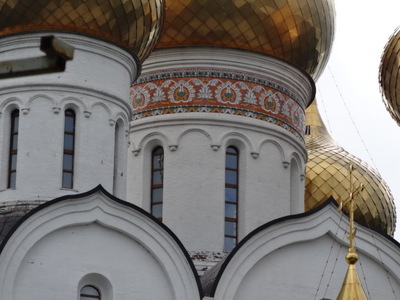
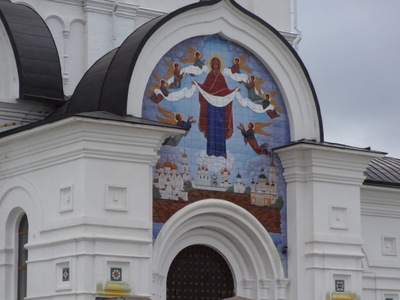 The Cathedral of the Dormition was much abused during the revolution, but a modern benefactor has paid for its restoration. The main building has recently been finished, but the 67-m bell tower has yet to be rebuilt.
The Cathedral of the Dormition was much abused during the revolution, but a modern benefactor has paid for its restoration. The main building has recently been finished, but the 67-m bell tower has yet to be rebuilt.
It is famous for its colored tiles, all of which use the same five colors—yellow, blue, brown, white, and green—each of which has some symbolic meaning.
Yaroslavl used to have 250 working churches; now it's down to 25 because Stalin destroyed so many.
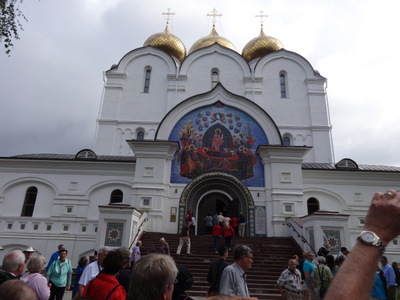
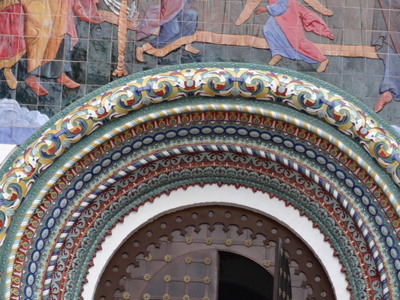 The tiles are used in panels and in linear friezes throughout the building and on the outside. As you can see in the left-hand photo, the main entrance is entirely framed by a large panel of tiles. Down nearer the ground, bands of them run around the building or punctuate architectural features.
The tiles are used in panels and in linear friezes throughout the building and on the outside. As you can see in the left-hand photo, the main entrance is entirely framed by a large panel of tiles. Down nearer the ground, bands of them run around the building or punctuate architectural features.
Closer up, I got the a shot of a portion of the main doorway, showing the tile work.
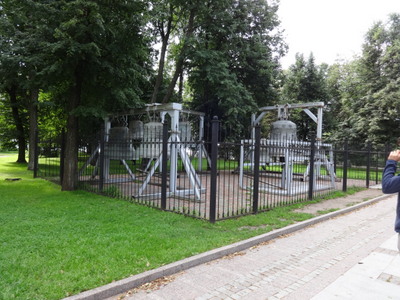
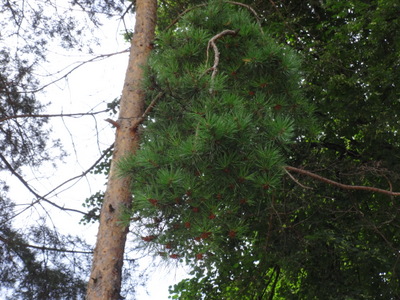 Off to one side, in a small fenced yard, the bells for the tower await its construction. The guide told us that, at the opening ceremony of the newly restored building, while the benefactor was at the microphone on the podium, an onlooker raised his hand and asked whether that was it or whether he had enough money to do the bell tower as well. Apparently, the benefactor was silent for a very long while before replying that, yes, he had enough money for the bell tower, too.
Off to one side, in a small fenced yard, the bells for the tower await its construction. The guide told us that, at the opening ceremony of the newly restored building, while the benefactor was at the microphone on the podium, an onlooker raised his hand and asked whether that was it or whether he had enough money to do the bell tower as well. Apparently, the benefactor was silent for a very long while before replying that, yes, he had enough money for the bell tower, too.
At the right here is a photo of the short-needled, red-barked pine we saw everywhere. Anybody have a clue what it is?
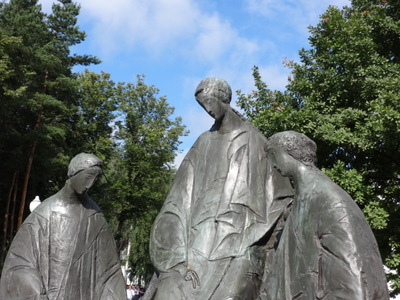
 While we were at the Dormition end of the esplanade, we visited this modern bronze of the three angels announcing to Abraham and Sara the impending birth of Isaac and this large stone, with an inscription on the front.
While we were at the Dormition end of the esplanade, we visited this modern bronze of the three angels announcing to Abraham and Sara the impending birth of Isaac and this large stone, with an inscription on the front.
The stone is supposed to possess "positive energy," which it will impart to those who touch or rub it; it's supposed to be especially helpful in matters of health. To get a clean photo of it, I had to wait while a large number of our shipmates did so (I gave it a pat myself, for luck) then got out of the way.
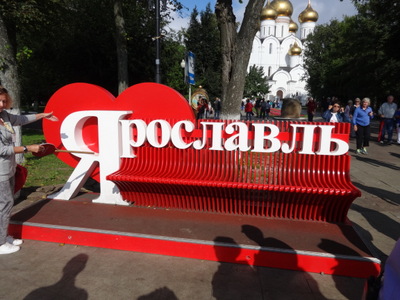
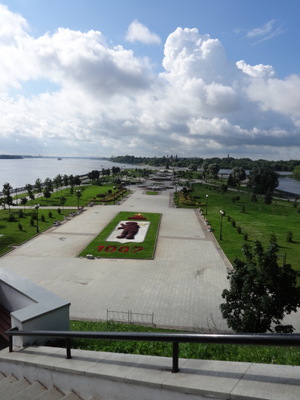
Finally, beyond the end of the esplanade, we came to a bluff that overlooked a flat, landscaped "island"—actually a moated part of the river bank, like the Kremlin in Uglich that serves as a commemorative park (I think it's called "Red October Park").
At the left here is a decorative park bench placed on the bluff for viewing of the park. The bench's back spells out "I [heart] Yaroslavl."
Looking out over the railing of the bluff (and the stairs down to the island) we saw this flower bed laid out to depict a Russian bear and the number "1007." The park and the flower bed were constructed for the town's 1000-year anniversary seven years ago, and at the time, the number was "1000"; now they replant it every year to reflect the new number of years since the city's founding.
In the far distance, beyond the water, you can just make out the spires of another church, St. John Chrisostome.
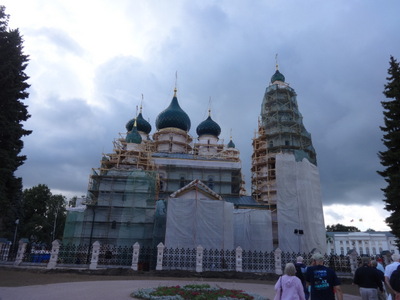
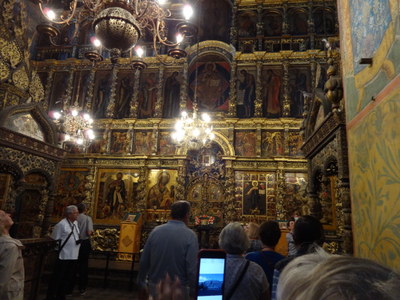 Then we walked the length of the esplanade to visit The Cathedral of Elijah the prophet. The guide told us that the esplanade used to be popular with artists who came in the winter especially to paint the the bulfinches against the backdrop of snows, "looking like apples on a white tablecloth."
Then we walked the length of the esplanade to visit The Cathedral of Elijah the prophet. The guide told us that the esplanade used to be popular with artists who came in the winter especially to paint the the bulfinches against the backdrop of snows, "looking like apples on a white tablecloth."
On the way, we stopped at the old bishop's palace for another short concert, this time by an male a capella vocal ensemble, this one called Vivat. Again, you can Google "Vivat vocal ensemble" to see and hear them.
At the far end, we came to St. Elija's, which took three years to build and paint in the 16th century. Unforunately, the exterior was largely covered with scaffolding when we were there, but this time, I had paid the fee to take photos inside, so here's what the interior of a Russian orthodox church looks like.
This shot faces the iconostasis as you enter. You can see the central door, flanked by the usual icons of Jesus and Mary. To either side, you can see the two canopied royal boxes.
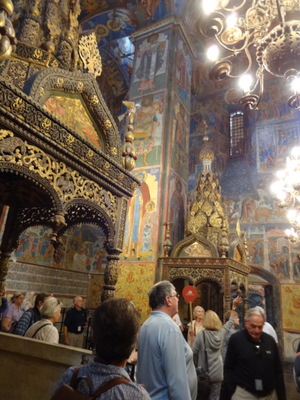
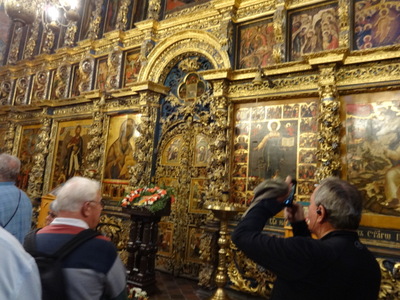 In this show taken between the iconostasis and the boxes, you can see the painted interior and the square columns supporting the ceiling. We asked whether the royal boxes had originally contained pews and were told indignant by the guide that they certainly didn't! They were sheltered from the jostling crowd by the boxes, but here, at least, even the Tsar and the Patriarch of the chur stood through the entire service.
In this show taken between the iconostasis and the boxes, you can see the painted interior and the square columns supporting the ceiling. We asked whether the royal boxes had originally contained pews and were told indignant by the guide that they certainly didn't! They were sheltered from the jostling crowd by the boxes, but here, at least, even the Tsar and the Patriarch of the chur stood through the entire service.
At the right here, you can see a closer view of the iconostasis. The icon to the right of Jesus (unfortunately, mostly obscured by glare) shows, as is traditional, the namesake of the church, St. Elijah, being brought food by crows in the wilderness.
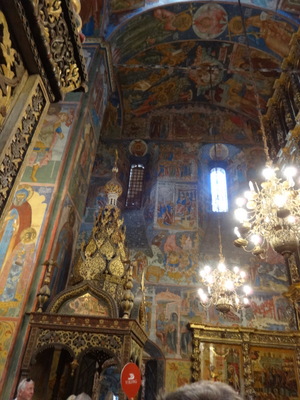
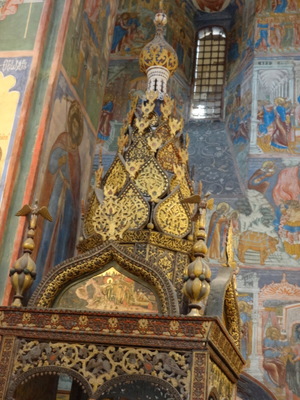 In these two photos, your can see more of the mural painting and the gold embelishment of the canopies of the royal boxes.
In these two photos, your can see more of the mural painting and the gold embelishment of the canopies of the royal boxes.
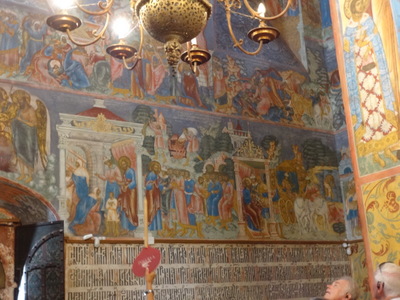
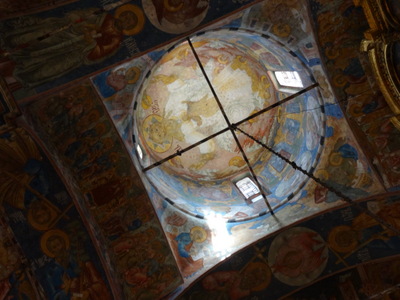 Here's a portion of the west wall, paint (again, as is traditional) with scenes of the last judgement, In the summer of 1680, a group of artists painted all these frescos in only three months.
Here's a portion of the west wall, paint (again, as is traditional) with scenes of the last judgement, In the summer of 1680, a group of artists painted all these frescos in only three months.
This is a summer church, richly painted. The adjoining winter church was heated by a stove, so painting wasn't so practical.
At the right is a view up into the lantern under the central dome. The ceilings and underside of the dome were just as richly painted as the rest of the interior (I say it again; always travel with binoculars).
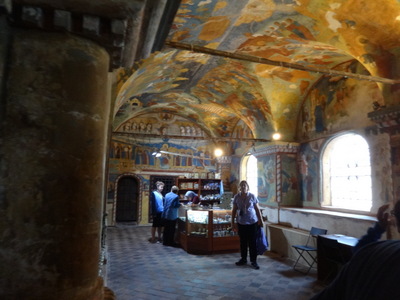
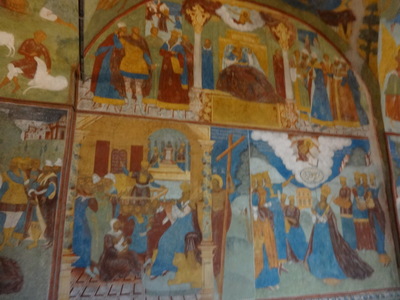 I think these last four photos are of the refectory (Russian orthodox churches don't have side aisles).
I think these last four photos are of the refectory (Russian orthodox churches don't have side aisles).
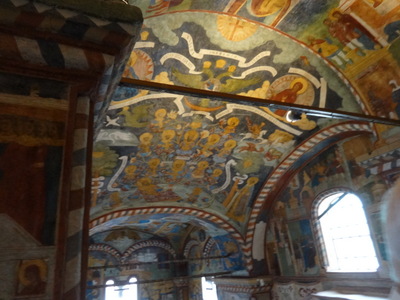
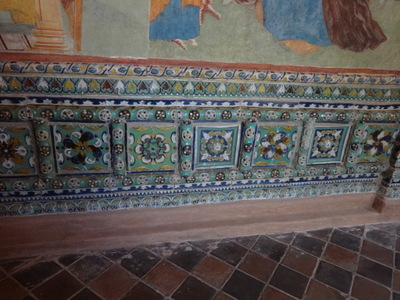 The right-hand photo here shows part of the tile frieze that ran around the refectory below the frescos.
The right-hand photo here shows part of the tile frieze that ran around the refectory below the frescos.
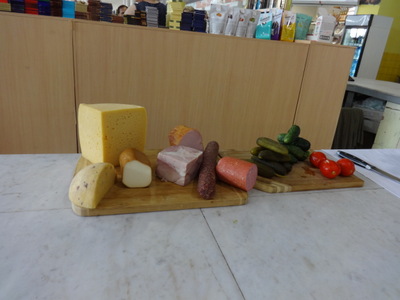
 From St. Elijah's, we took the buses to the city market, where we threaded our way through a maze of ramshackle huts, each housing a market stall, to the covered central market where we found, to my surprise, our very own chef Leonidas, who had laid out an array of products (assembled for display in the left-hand photo; the cucumbers are not fresh but pickled) for us to taste, decorated by large bouquets of local dill and parsley.
From St. Elijah's, we took the buses to the city market, where we threaded our way through a maze of ramshackle huts, each housing a market stall, to the covered central market where we found, to my surprise, our very own chef Leonidas, who had laid out an array of products (assembled for display in the left-hand photo; the cucumbers are not fresh but pickled) for us to taste, decorated by large bouquets of local dill and parsley.
After sampling them, we were turned loose to check out the rest of the market. These were not farmers in from the country to sell their products on market day but established vendors with permanent stalls in the covered market.

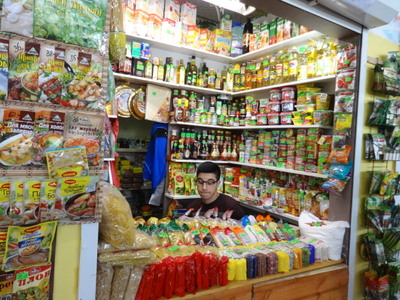 At the left here is a huge array of nuts and dried fruits, just one side of a four-sided layout. The basket of whole cracked pecans it the upper row at the left-hand side of the photo were strangely pale-colored, but the wares were largely the ones we can get here. The pile of small logs near the far end seemed to be plastic-wrapped rolls of fruit leather.
At the left here is a huge array of nuts and dried fruits, just one side of a four-sided layout. The basket of whole cracked pecans it the upper row at the left-hand side of the photo were strangely pale-colored, but the wares were largely the ones we can get here. The pile of small logs near the far end seemed to be plastic-wrapped rolls of fruit leather.
The stall in the right-hand photo sold canned, jarred, and dry items (like pasta and beans). Interesting to see familiar items Maggi soup mixes and Kikkoman soy sauce labeled in Russian.
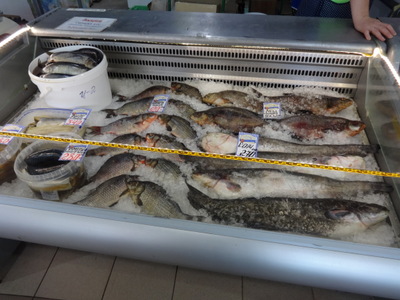
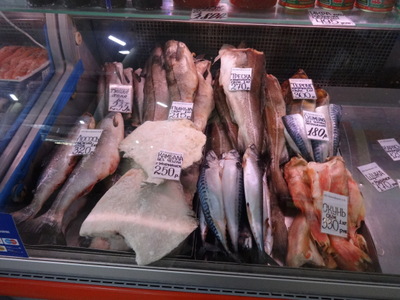 Here are two views showing perhaps 1/3 of a fairly large selection of fresh fish. The species were mostly familiar, though transliterating the names didn't help, as they all had Russian names rather than ones borrowed from other languages (though the name on the mackerel looked a lot like the Latin family name).
Here are two views showing perhaps 1/3 of a fairly large selection of fresh fish. The species were mostly familiar, though transliterating the names didn't help, as they all had Russian names rather than ones borrowed from other languages (though the name on the mackerel looked a lot like the Latin family name).
One case even included whole fresh cod (gutted, head off).
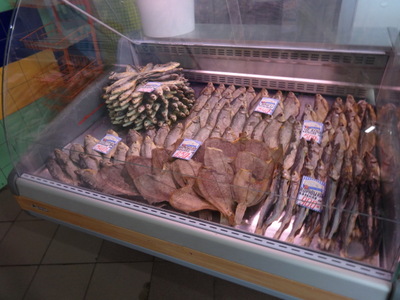
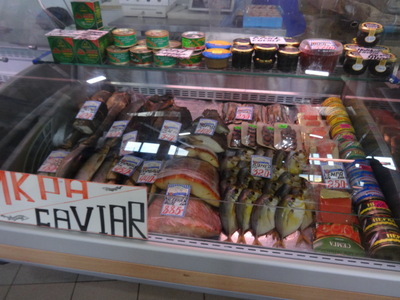 The selection of dried and smoked fish was just as large, if not larger.
The selection of dried and smoked fish was just as large, if not larger.
The left-hand photo shows whole dried (smoked?) fishes; I especially like the neat spiral stack of little ones at the back left.
The right-hand photo shows some whole fish (the ones in the front look like pompanos), but it also shows large slabs of whole boneless smoked filets, and it heavily features caviar (helpfully labeled in English on the hand-lettered sign, for the convenience of tourists).
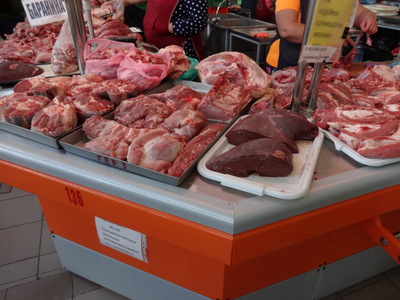
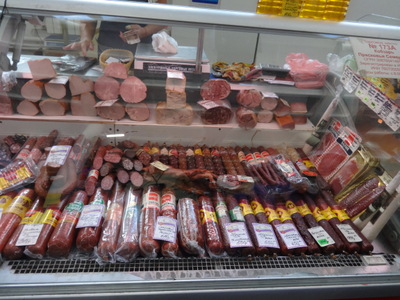 At the left here is one of several meat and poultry displays, prominently featuring the liver front and center—pork, I think, though it may have been veal. Other displays consisted of veal (or pork?), beef, chickens, quail, and some game.
At the left here is one of several meat and poultry displays, prominently featuring the liver front and center—pork, I think, though it may have been veal. Other displays consisted of veal (or pork?), beef, chickens, quail, and some game.
At the right is one of many displays of sausages and other charcuterie.
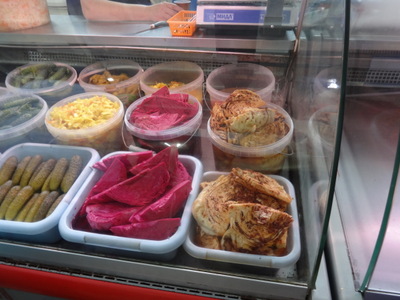
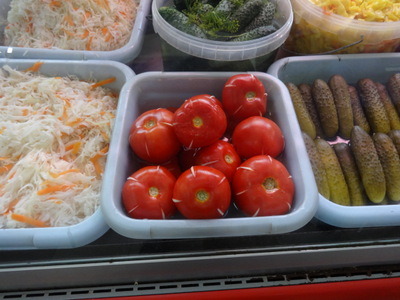 As in France, many stalls were selling cooked, raw, and marinated vegetable salads and relishes. I was particularly struck by these marinated whole wedges of cabbage in several flavors, which I'd never seen before.
As in France, many stalls were selling cooked, raw, and marinated vegetable salads and relishes. I was particularly struck by these marinated whole wedges of cabbage in several flavors, which I'd never seen before.
In the same case were these whole tomatoes, which had been been slit at six places. Slivers of something white—onion or garlic, I suspect&Mdash;had been inserted to flavor them.
In other nearby cases were bins of carrot slaw, other half- and full-pickled cucumbers, what looked like kim chi, coleslaws, pickled mushrooms, stuffed grape leaves, grape leaves ready for stuffing, peperoncini, shredded celery root, whole pickled heads of young garlic, and pickled long smooth thin curved stems of something (stalks of leek flowers?).
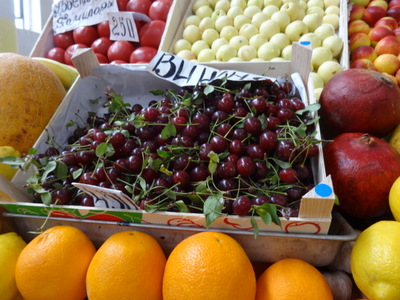
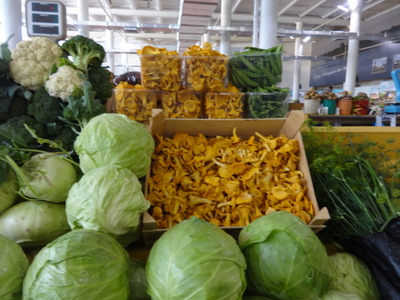 Among the fresh produce were these sour cherries (left) and huge bins of fresh chanterelle mushrooms (right).
Among the fresh produce were these sour cherries (left) and huge bins of fresh chanterelle mushrooms (right).
The display included all the usual stuff as well—apples, oranges, grapefruit, several kinds of melon (including watermelon), mangoes, pomegranates, currants, strawberries, bananas, cabbages, tomatoes, herbs (including huge bundles of dill), peaches, nectarine, peppers, broccoli, caulifower, grapes, lemons, figs, apricots, eggplant, zucchini (no yellow summer squash; that seems to be uniquely American), winter squash, onions, potatoes (of several sizes and colors). I don't recall seeing any "Latin" vegetables, like yuca or yams, or any "southern" stuff, like okra or sweet potatoes.
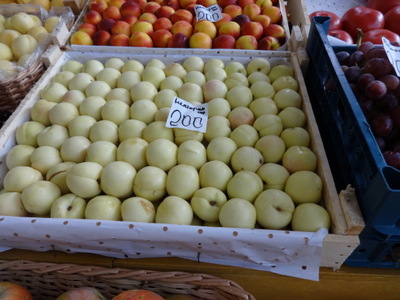
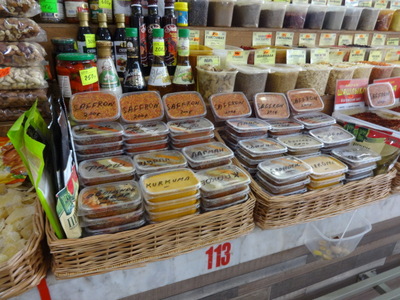 Among the items I'd never seen before are these small, white nectarines (left-hand photo). We never got to taste them.
Among the items I'd never seen before are these small, white nectarines (left-hand photo). We never got to taste them.
The spice counter displayed lots of familiar items, some labeled in Roman letters, like the prominently displayed tubs of "saffron" priced at 200 rubles ($2.50) for about a pint (how good could it be?) and the "kukurma" (turmeric). Many of the tubs were filled with stripes of different spices, presumably mixures intended for various dishes (I could read "shashlik" on one lid).
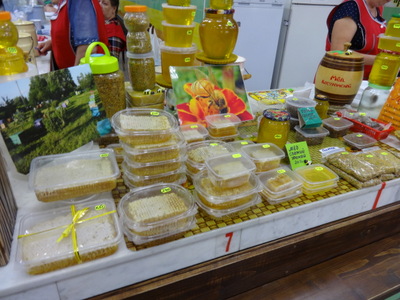
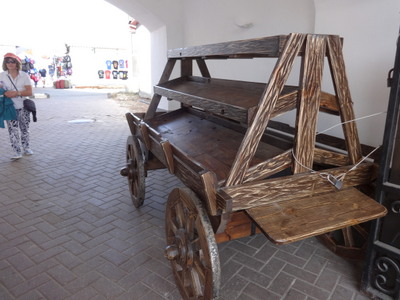 The stall on the left here sold honey and bee products. The honey was sold in the comb, in jars, and in bulk, and the display also included cakes of beeswax and jars and bags of what was probably pollen. Something I didn't notice at the time but spotted later in the photo was tubs of moist dark greenish pellets labled "Perga," which the internet tells me is "bee bread," a fermented mixture of honey and pollen.
The stall on the left here sold honey and bee products. The honey was sold in the comb, in jars, and in bulk, and the display also included cakes of beeswax and jars and bags of what was probably pollen. Something I didn't notice at the time but spotted later in the photo was tubs of moist dark greenish pellets labled "Perga," which the internet tells me is "bee bread," a fermented mixture of honey and pollen.
In the doorway of the market was this (probably purely ornamental) antique handcart with angled shelves for display of goods in an outdoor market.
Despite all these photos, I didn't even mention the many ready-to-cook foods, like breaded cutlets, meatballs, rissoles, stuffed leaves of cabbage, filled crepes, and stuffed peppers. Several stalls sold cheeses and other dairy products like milk, cream, yogurt, and ice cream. The most popular cheeses seemed to be firm and semifirm washed-rind things (ranging from, say, Havarti to Swiss); smoked cheeses (of several kinds; they were skelling great skeins of Chechil spaghetti); and soft spreadable processed cheeses. Not much in the say of, say, Brie, Camembert, or flower-rinded ripened goat cheeses.
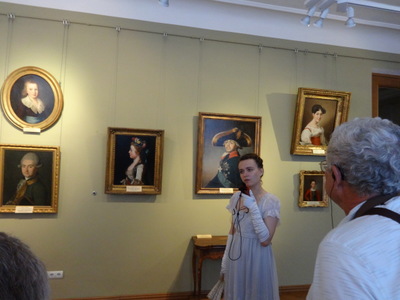
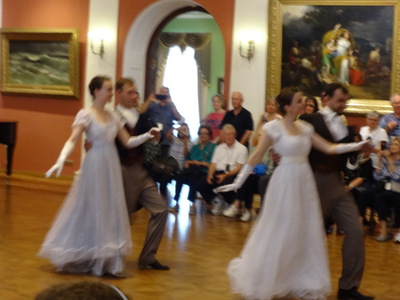 Next up after the market was the tour of the governor's house, now a museum. We were met there by our local guide, one of a corps of young women who dress in period costume and conduct tours in the guise of the governor's daughter. They're good, but they still often get tangled up in their verb tenses while trying to answer modern questions while remaining in period character. Here, our guide points out some of the most significant portraits on display. Behind her, you can see young Paul I again.
Next up after the market was the tour of the governor's house, now a museum. We were met there by our local guide, one of a corps of young women who dress in period costume and conduct tours in the guise of the governor's daughter. They're good, but they still often get tangled up in their verb tenses while trying to answer modern questions while remaining in period character. Here, our guide points out some of the most significant portraits on display. Behind her, you can see young Paul I again.
After the tour, we assembled in the ballroom to listen to classical music by a trio of piano, violin, and cello. Our guide and other young people in period costume then demonstrated period dance steps. Inevitably, they then called for volunteer partners from the audience (we know never to stand in the front row and never to make eye contact) and went through the dances again, ending with a polka.
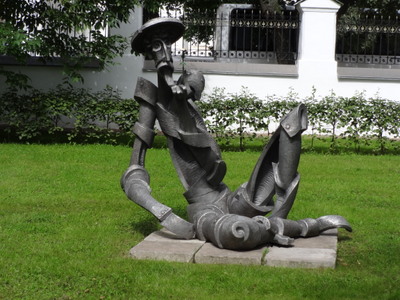
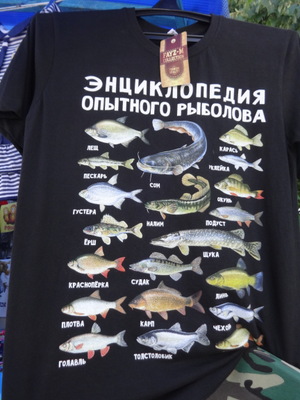 After running the gauntlet of very high-end souvenir sellers who positioned themselves strategically between the governor's house and the buses—they actually had some lovely stuff, especially the lacquered boxes, but we weren't really in the market— we passed this wonderful 1987 sculpture of Don Quixote by Nikolay Andreyevich Silis (transliterating the Russian label yielded the French pronunciation, "Don Keeshot" with a long "o").
After running the gauntlet of very high-end souvenir sellers who positioned themselves strategically between the governor's house and the buses—they actually had some lovely stuff, especially the lacquered boxes, but we weren't really in the market— we passed this wonderful 1987 sculpture of Don Quixote by Nikolay Andreyevich Silis (transliterating the Russian label yielded the French pronunciation, "Don Keeshot" with a long "o").
And as we ran the somewhat lower-end gauntlet of vendors at the dock, I got this photo of a wonderful t-shirt that I would like to have as a poster. When I get a chance, I'll compare it carefully to my illustrated Fishes of Europe to work out the English and Russian names.

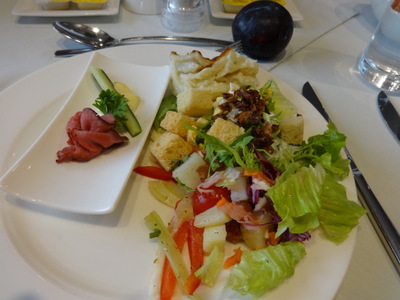 After leaving at 8:15 a.m. and doing all that, we were still back aboard by 11:45 a.m., and the ship cast off once more as we sat down to lunch!
After leaving at 8:15 a.m. and doing all that, we were still back aboard by 11:45 a.m., and the ship cast off once more as we sat down to lunch!
The appetizer menu was better than the main courses. Somebody (David?) went straight for the regional-specialty main course, Russian beef stew with potatoes, carrots, peas, and spring onions (left-hand photo).
I, on the other hand, got some salad from the salad bar, together with the "classic roast beef" (on a small plate next to the salad) and a small sample of the hot hors d'oeuvre, "potato gratin with chives sauce" (at the back of the plate).
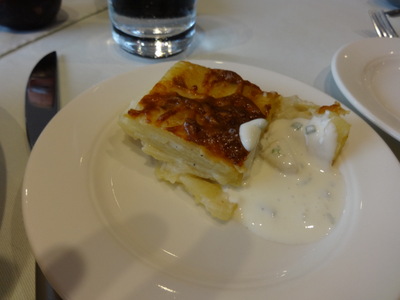
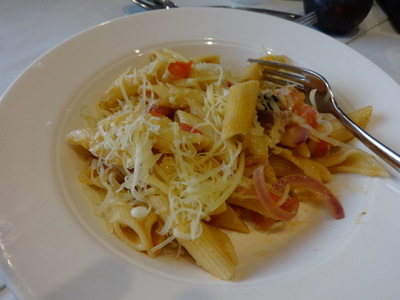 Both proved excellent, so I went back for a larger serving of the potato gratin (not quite gratin Dauphinois, but pretty good anyway).
Both proved excellent, so I went back for a larger serving of the potato gratin (not quite gratin Dauphinois, but pretty good anyway).
Neither of the other two main courses interested me: chicken broth with pasta, veggies, and herbs and a muffaletta sandwich (like being greated by Russian buskers playing When the Saints Go Marching In!). So I had the penne putanesca from the pasta station. Ev resorted to his usual lunchtime strategem when everything contained onions and garlic—lots of the pasta of the day dressed with plain butter and lots of cheese.
I don't seem to have taken photos of the Mozart cake with fruit sauce or the Stracciatella ice cream with warm port wine grapes.
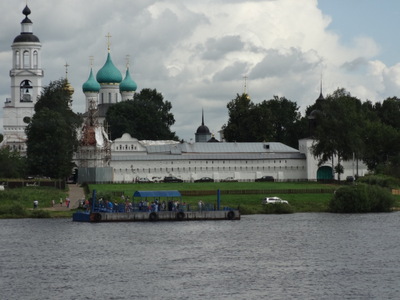
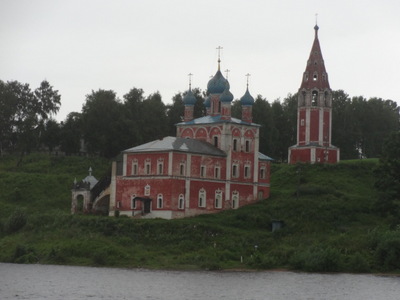 Leaving Yaroslavl, we retraced our steps (wake?) along the Volga. The left-hand photo shows a square gray ferry dock with a blue awning. It seems that in 1822 the Tsar (I guess that would have been Alexander I) ordered two towns (Romanov and Borisoglebsk) on opposite sides of the Volga to merge, which of course they did. For a while, they just hyphenated the two names together, but in 1918 they changed the name to Tutaev. They still have no bridge, so they use a ferry to shuttle from one side of town to the other. The ferry itself cross behind us as we cruised by.
Leaving Yaroslavl, we retraced our steps (wake?) along the Volga. The left-hand photo shows a square gray ferry dock with a blue awning. It seems that in 1822 the Tsar (I guess that would have been Alexander I) ordered two towns (Romanov and Borisoglebsk) on opposite sides of the Volga to merge, which of course they did. For a while, they just hyphenated the two names together, but in 1918 they changed the name to Tutaev. They still have no bridge, so they use a ferry to shuttle from one side of town to the other. The ferry itself cross behind us as we cruised by.
The right-hand photo is of yet another random picturesque church all by itself on the river bank.
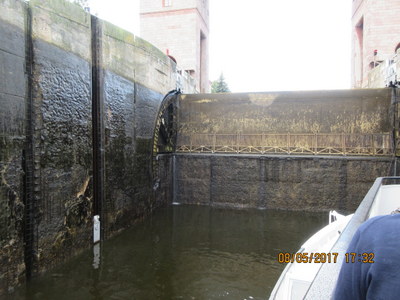
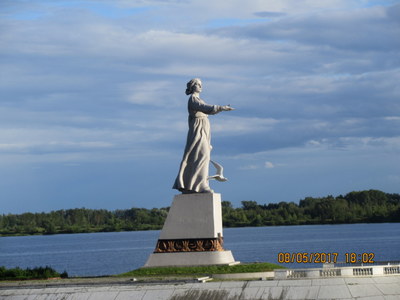 Arriving back at the point where the Volga met the Rybinsk reservoir, we passed a second time through the same lock we had passed through when we left the reservoir on our way to Yaroslavl. That passage took place in the wee hours of the morning, so this was our first chance to get a good look at the lock.
Arriving back at the point where the Volga met the Rybinsk reservoir, we passed a second time through the same lock we had passed through when we left the reservoir on our way to Yaroslavl. That passage took place in the wee hours of the morning, so this was our first chance to get a good look at the lock.
Ev ws the one to notice that this one had an opening and closing mechanism we'd never seen before. Most locks open or close with a pair of swinging doors at each end or "guillotine style" with a door that slides up and down, but this one had a door that rotated around a horizontal axis! You can see the one of the two big toothed wheels at its ends in the left-hand photo. We entered on the low side, and when Ev pointed out the mechanism, I at first couldn't believe that, even when we had risen to the high-water mark clearly visible on the wall, the door would rotate to a depth we could sail over! But it did. Our ship only draws about 10 ft, and once the lock was filled and the door rotated to the horizontal position, we cruised right over it. That mechanism must severely limit the draft of ships that can travel through the
Note also how clean the lock walls are. That was the case with every lock we saw. I don't know whether they clean them often or whether the latitude just serves to keep the algae and freshwater mussels off. We asked the captain about zebra mussels (a real nuisance of an invasive exotic in the Great Lakes), but he pooh-poohed the idea that they would be a problem here.
Finally, as we cruised out of the lock and back into the reservoir, we passed the famous giant statue of "Mother Volga," at which point my camera battery died. The spare was right there in my pocket, but I couldn't changed it fast enough to get a shot before we sailed past, so the right-hand photo is one of Ev's, as is the shot of the lock mechanism.
We again cruised all afternoon and all night, so the time was again filled by lectures and activities. The offerings were, in order, "Russia in the 20th Century" presented by Sasha (in two shifts) in the Sky Bar, tea time in the Panorama Bar (a smaller, quieter venue not infested by the ship's musicians), a short briefing by Margo about our next port of call, "Discover the World of Viking" presented by Margo (at which you could hear about other Viking itineraries and buy special discounts on future cruises available only on board), the regular cocktail party in the Panorama Bar, and the overlapping Viking Explorers' Society cocktail party in the Sky Bar.
I went to the lecture on Russia in the 20th century and took notes, but I found it far less interesting than hearing about the Romanovs, about whom I was genuinely curious. Anyway, after the revolution, the capital was moved back to Moscow. First Lenin was in charge (died in 1922), then Stalin (died in 1953, and after him Khruschev. He was succeeded in 1964 by Breshnev. Then Andropov (1982), then Chernenko (1984), then Gorbachev (1985), then Yeltsin (1991), Putin (2000), then Medvedev (2008), and now Putin again since 2012.
I already read Viking's catalogues, and I was anxious to transcribe my notes for the day, so I skipped the tea and the "discover" lecture, but we were curious about the VES cocktail party. Now that we were on our second cruise, we were VES members (all it takes is to have sailed with Viking before) so we went to see what it was like. Like nothing much, as it turns out. Margo welcomed us, and free cocktails were distributed it, and then it was just a cocktail party.
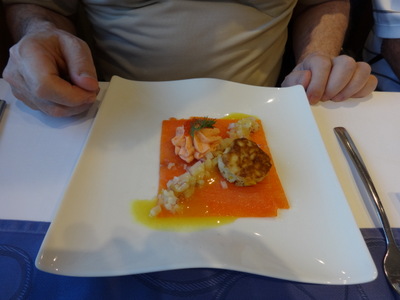
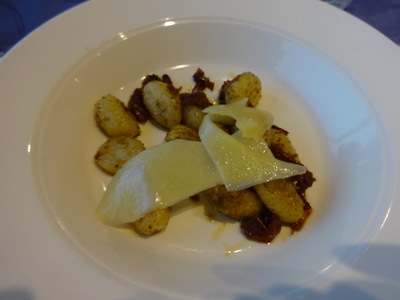 For dinner, David (predictably) started with the carpaccio of Smoked Kamchatka salmon with lemon vinaigrette, sweetcorn blini, and salmon mousse.
For dinner, David (predictably) started with the carpaccio of Smoked Kamchatka salmon with lemon vinaigrette, sweetcorn blini, and salmon mousse.
I opted for the potato gnocchi with pesto and sundried tomatoes. Very good.
Ev had the cheese plate as usual (Gorgonzola and Chechil spaghetti again), and Rachel had the "tossed mesclun salad with crisp focaccia with fresh fig, raspberry vinaigrette, pineapple, and dried cranberry.
I don't think anybody had the cream of zucchini soup with garlic croutons.
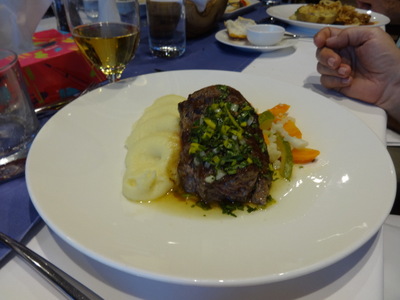
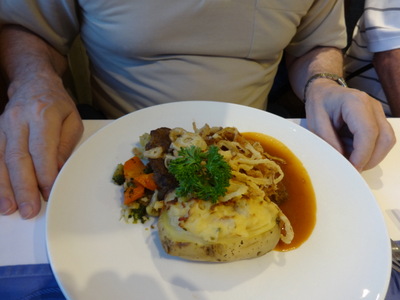 Rachel ordered the beef tenderloin (with the chimichurri that they always left off for Ev), and David had the "braised onion steak" with stuffed baked potato.
Rachel ordered the beef tenderloin (with the chimichurri that they always left off for Ev), and David had the "braised onion steak" with stuffed baked potato.
I don't actually remember what I had. Maybe the seared fillet of halibut with white beans and bouillabaisse sauce, or maybe just the beef tenderloin. Not memorable, whatever it was. Ev probably had the halibut, without sauce.
Nobody ordered the saffron risotto with preserved orange, snow peas, ricotta, and roasted fennel.
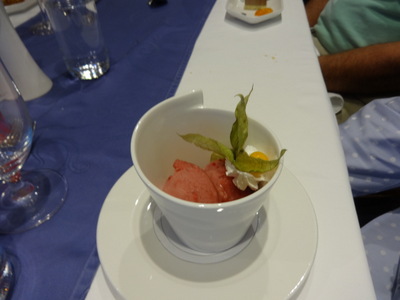
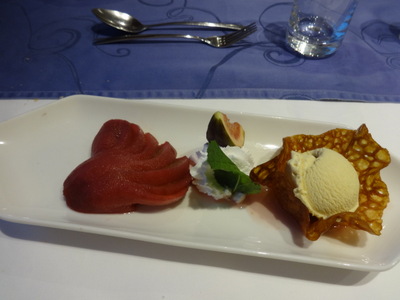 Somebody ordered the raspberry sorbet (left-hand image), but the rest of us had the red wine poached pear with ginger ice cream in a caramel cup, which was delicious. The object behind the whipped cream is a wedge of fresh fig.
Somebody ordered the raspberry sorbet (left-hand image), but the rest of us had the red wine poached pear with ginger ice cream in a caramel cup, which was delicious. The object behind the whipped cream is a wedge of fresh fig.
All morning in Yaroslavl, we had gorgeous cool, sunny, breezy weather, but cruising back the way we came and then crossing the reservoir, we passed through periodic heavy rain squalls.
I finally spotted a raptor as we cruised, in fact a whole collection of them, circling overhead. Dark top and bottom; head and tail a little lighter than the wings. I consulted the ship's only field guide (Birds of Europe and Asia: Non-passerines, from Loons to Woodpeckers), which actually included raptors, but I couldn't identify them. From the choices offered, I think they must have been some kind of eagle.
The evening's entertainment (aside from live music with Sigmund and Elena) was "A Question of Music." Margo played 11 songs, and we had to write down the artist, the title, and the artist's nationality. 10 points for each of the three answers and 10 bonus points if a member of the team got up and danced to the music (20 bonus for questions 9 and 10 and 30 bonus for number 11). Never one to leave points on the table, Rachel took care of all the bonuses. Rachel and Ev immediately recognized Sweet Caroline, and I knew it was by Neil Diamond. They also knew Day Dream Believer and that it was by the Monkees. I knew the Monkees were American, but Ev and Rach overruled me, insisting they were British, so we got that one wrong. In all, we scored 400 points, but the top two teams scored 440 and 470.
Previous entry List of Entries Next entry